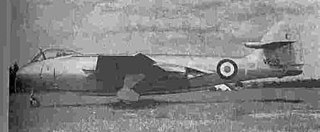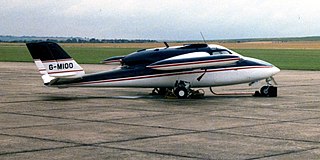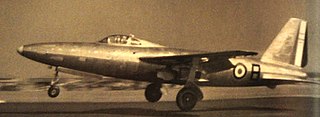Related Research Articles

The Republic XF-91 Thunderceptor is a mixed-propulsion prototype interceptor aircraft, developed by Republic Aviation. The aircraft would use a jet engine for most flight, and a cluster of four small rocket engines for added thrust during climb and interception. The design was largely obsolete by the time it was completed due to the rapidly increasing performance of contemporary jet engines, and only two prototypes were built. One of these was the first American fighter to exceed Mach 1 in level flight.

The Douglas D-558-2 Skyrocket is a rocket and jet-powered research supersonic aircraft built by the Douglas Aircraft Company for the United States Navy. On 20 November 1953, shortly before the 50th anniversary of powered flight, Scott Crossfield piloted the Skyrocket to Mach 2, or more than 1,290 mph (2076 km/h), the first time an aircraft had exceeded twice the speed of sound.

The Bréguet Br 960 Vultur was a prototype two-seat carrier-based attack and anti-submarine aircraft (ASW) built for the French Navy during the early 1950s. Meeting contradictory endurance and speed requirements, it was designed as a "mixed-power" aircraft with a turboprop engine in the front and a turbojet in the rear. Only two examples were built, but the second aircraft was rebuilt as the prototype of the Bréguet 1050 Alizé ASW aircraft after the Navy dropped the idea of a turboprop attack aircraft in the mid-1950s.

The Hawker P.1072 was a 1949 experimental British aircraft acting as a test bed for the Armstrong Siddeley Snarler rocket booster engine. It was the prototype Hawker Sea Hawk modified to install the rocket in the tail.

The Temco TT Pinto is a tandem two-seat primary jet trainer built for the United States Navy by Temco Aircraft of Dallas, Texas.

The Turbomeca Marboré is a small turbojet engine that was produced by Turbomeca from the 1950s into the 1970s. The most popular uses of this engine were in the Fouga CM.170 Magister and the Morane-Saulnier MS.760 Paris. It was also licensed for production in the United States as the Teledyne CAE J69.

The Turbomeca Palas is a diminutive centrifugal flow turbojet engine used to power light aircraft. An enlargement of the Turbomeca Piméné, the Palas was designed in 1950 by the French manufacturer Société Turbomeca, and was also produced under licence by Blackburn and General Aircraft in the United Kingdom and Teledyne Continental Motors in the United States as the Continental Model 320.

The Ambrosini Sagittario was an Italian aerodynamic research aircraft based on the manufacturer's S.7. New swept wings and tail surfaces of wooden construction were fitted to the S.7 fuselage. The wing leading edge was swept at 45 degrees. At first, the S.7's piston engine was retained and the aircraft was known as the Ambrosini S.7 Freccia (Arrow).

The Miles M.100 Student was built as a lightweight trainer as a private venture by F.G. and George Miles with development started in 1953. Although not specifically a Miles product, it was promoted as a British Royal Air Force trainer but failed to enter production.

The Ikarus 451 is a family of research aircraft designs built in Yugoslavia in the 1950s, all sharing the same basic airframe, but differing in powerplants and cockpit arrangements. One member of the family Ikarus 451M became the first domestically-built jet aircraft to fly in Yugoslavia, on 25 October 1952.

The Leduc 022 was the prototype of a mixed-power French interceptor built in the mid-1950s. Designer René Leduc had been developing ramjet-powered aircraft since before World War II and had flown a series of experimental aircraft, the Leduc 0.10 and Leduc 0.21, throughout the Fifties before he was awarded a contract for two examples of a short-range supersonic interceptor armed with two air-to-air missiles (AAMs).

The SIPA S.200 Minijet was a light sporting jet aircraft designed and produced by the French aircraft manufacturer Société Industrielle Pour l’Aéronautique (SIPA). It is designed to perform liaison, training, and aerobatic flights. The Minijet was claimed to be the first jet-powered light touring aircraft

The Yakovlev Yak-1000 was a Soviet supersonic technology demonstrator intended to evaluate the aerodynamic layout and field performance of the cropped delta wing discussed in captured German documents in combination with the new Lyulka AL-5 turbojet. The tandem undercarriage proved to be unsatisfactory and there were serious flight stability problems related to the delta wing, enough so that it never flew after an accident during taxiing tests.

The Payen Pa 49 Katy was a small experimental French turbojet powered tailless aircraft, designed by Nicolas Roland Payen, and first flown in 1954. It was the first French aircraft of this kind and the smallest jet aircraft of its day.

The Caproni Trento F.5 was a small Italian two-seat trainer designed by Stelio Frati and built by Aeroplani Caproni Trento. The F.5 was not ordered into production and only a prototype was built.
The Somers-Kendall SK-1 was a light jet-powered 1950s British two-seat racing monoplane, designed by Hugh Kendall and built by Somers-Kendall Aircraft Limited at Woodley Aerodrome.
The Procaer Cobra was a two-seat turbojet powered light aircraft designed and built in Italy and flown in the early 1960s. Only one was completed.

The CVV-6 Canguro was a high performance two seat glider, designed at Milan Polytechnic University in 1940. A small batch was ordered for the Italian Air Force but few were delivered; more were produced after World War II, becoming the most common Italian gliding club machine. Some were still in use in the 1980s. In 1954 a Canguro came second at the World Gliding Championships at Camphill Great Hucklow, Derbyshire, England. One was modified into a powered aircraft, at first with a piston engine and later with a turbojet.
The EFF Prometheus was an unusual two seat motor glider powered by a pair of small turbojet engines, designed and constructed in Switzerland in the 1970s. Two versions with different spans were built, but it did not go into production.

The Sud-Ouest SO.6020 Espadon (Swordfish) was a French post-war prototype interceptor designed and built by SNCASO during the late 1940s. The French Air Force judged the design a failure despite some records being set and cancelled plans to put it into service in 1951. Only four aircraft were built and they were later modified to serve as testbeds for the mixed rocket and turbojet-powered SNCASO SO.9000 Trident program. Only one badly damaged aircraft survives.
References
- 1 2 3 "Sipa 300" . Retrieved 2011-05-02.
- ↑ "Aircraft intelligence". Flight . No. 22 October 1954. p. 615.
- 1 2 Green, William; Cross, Roy (1955). The Jet Aircraft of the World. London: McDonald. p. 170.
- 1 2 3 4 Bridgman, Leonard (1956). Jane's All the World's Aircraft 1956-57. London: Jane's All the World's Aircraft Publishing Co. Ltd. pp. 157–8.
- ↑ Green, William (1955). Aircraft of the World. London: McDonald. p. 170.
- ↑ "The Paris show". Flight . No. 17 June 1955. p. 834.
- ↑ "Weekend in Paris". Flight . No. 24 June 1955. p. 868.